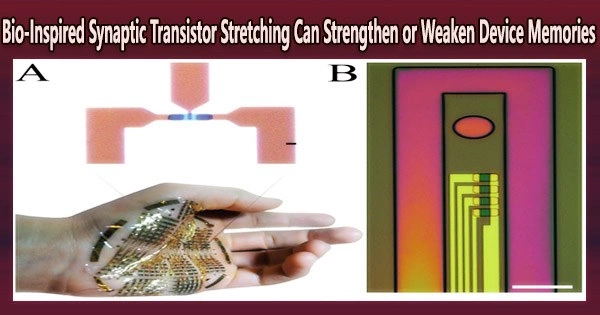A flexible, wearable synaptic transistor created by Penn State engineers may soon make robotics and wearable technology a little smarter. In order to strengthen and weaken the gadget’s memory, the device functions like neurons in the brain by sending signals to some cells while inhibiting others.
Led by Cunjiang Yu, Dorothy Quiggle Career Development Associate Professor of Engineering Science and Mechanics, and associate professor of biomedical engineering and of materials science and engineering, the team designed the synaptic transistor to be integrated in robots or wearables and use artificial intelligence to optimize functions.
“Mirroring the human brain, robots, and wearable devices using the synaptic transistor can use its artificial neurons to ‘learn’ and adapt their behaviors,” Yu said. “For example, if we burn our hand on a stove, it hurts, and we know to avoid touching it next time. The same results will be possible for devices that use the synaptic transistor, as the artificial intelligence is able to ‘learn’ and adapt to its environment.”
The device’s artificial neurons, according to Yu, were created to mimic the behavior of neurons in the ventral tegmental region, a small section of the human brain situated near the top of the brain stem.
By designing the synaptic transistor to operate with both synaptic behaviors simultaneously, fewer transistors are needed compared to conventional integrated electronics technology, which simplifies the system architecture and allows the device to conserve energy.
Cunjiang Yu
Neurotransmitters are released at synapses, which are normally found at the ends of brain cells, by neurons as they process and send information. While inhibitory neurotransmitters suppress other neurons’ activity and are linked to weakened memories, excitatory neurotransmitters increase the activity of other neurons and are thought to improve memory.
“Unlike all other areas of the brain, neurons in the ventral tegmental area are capable of releasing both excitatory and inhibitory neurotransmitters at the same time,” Yu said. “By designing the synaptic transistor to operate with both synaptic behaviors simultaneously, fewer transistors are needed compared to conventional integrated electronics technology, which simplifies the system architecture and allows the device to conserve energy.”
The device, which can stretch and twist when in operation, was made by the researchers using stretchable bilayer semiconductor materials to imitate soft, extensible biological tissues, according to Yu. Conventional transistors, on the other hand, are rigid and will break when deformed.
“The transistor is mechanically deformable and functionally reconfigurable, yet still retains its functions when stretched extensively,” Yu said. “It can attach to a robot or wearable device to serve as their outermost skin.”
In addition to Yu, other contributors include Hyunseok Shim and Shubham Patel, Penn State Department of Engineering Science and Mechanics; Yongcao Zhang, the University of Houston Materials Science and Engineering Program; Faheem Ershad, Penn State Department of Biomedical Engineering and University of Houston Department of Biomedical Engineering; Binghao Wang, School of Electronic Science and Engineering, Southeast University and Department of Chemistry and the Materials Research Center, Northwestern University; Zhihua Chen, Flexterra Inc.; Tobin J. Marks, Department of Chemistry and the Materials Research Center, Northwestern University; Antonio Facchetti, Flexterra Inc. and Northwestern University’s Department of Chemistry and Materials Research Center.
The Office of Naval Research, the Air Force Office of Scientific Research, and the National Science Foundation supported this work.





